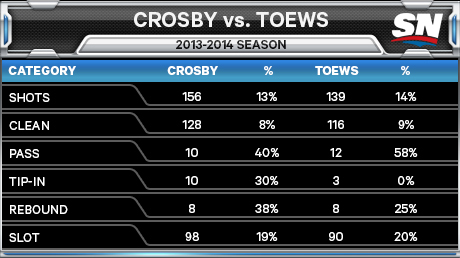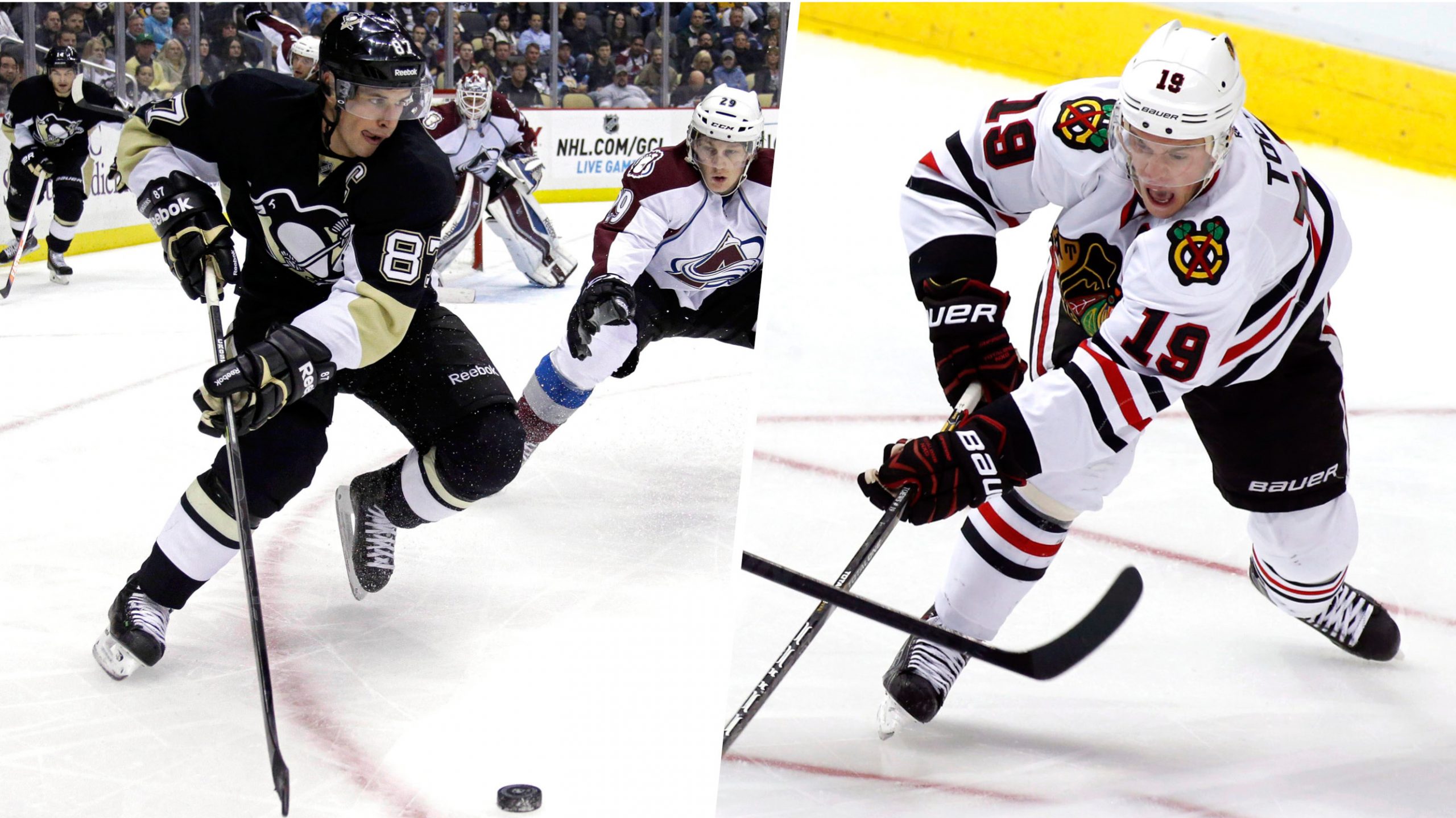As the likely 2014 Hart Trophy winner, Sidney Crosby is currently recognized as the best player in the world. Traditional stats as well as advanced data analysis confirms it. The only player who has the individual trophy case to challenge Crosby is Alex Ovechkin, but his reputation is currently stained, with a minus-35 being the darkest. Those who believed Ovechkin was a one-dimensional player now have their opinions confirmed.
Jonathan Toews is one player who has been placed in the same rarefied air as Crosby. During the past two Olympics, right or wrong, pundits have put Toews in Crosby’s league. Toews is recognized as a Mark Messier-style leader whose game is one of the most complete in the world. His team accomplishments outstrip the Penguins’ with more Stanley Cups (2 to 1) and World Junior Championships (2 to 1) on his mantle, along with a Conn Smythe Trophy and a Selke Trophy to commemorate his dominant defensive play.
While reviewing both players, Toews did manage to register a better shots-for percentage than Crosby—59 to 54 percent—as well as a goals-for percentage, 61 to 54 percent.

Crosby’s line managed better shot quality metrics but the possession battle significantly favoured Toews. The data points to Toews as the better even strength player, until I add some context.
Advanced statistics do have ways to separate individuals with Relative Corsi and WOWY (with or without you), but it is a work in progress, one that will continue to improve as the data improves. While tracking all even-strength shots for and against with each of them on the ice it became clear who had the better supporting cast. Earlier this season, Tyler Dellow pointed out why the Penguins aren’t truly a Cup contender and you can see this with Crosby’s linemates. The Penguins don’t have the depth to support Crosby on the top line like the Blackhawks and it shows when we highlight the they are most often on the ice with this season when their teams register a shot on goal.

While Toews benefits from sharing the majority of his ice with Marian Hossa, Patrick Sharp, Duncan Keith and Brent Seabrook, Crosby is “bolstered” by a foursome of Chris Kunitz, Pascal Dupuis, Brooks Orpik and rookie Olli Maatta. Unlike with Toews in Chicago, Crosby must drive the play for the top unit to be successful in Pittsburgh.
The Toews unit is also helped by an easier zone start ratio (O/DSt% 63.6 to 50.4) while both lines manage tough minutes with a similar quality of competition.

We can see that the Blackhawks’ unit overwhelms the competition with quantity. And while the Toews line outscored Crosby’s 65-61 through 72 games, the Penguins top unit managed to bridge the 34-shot gap by creating more high-quality opportunities via traffic in front (tips +11), second-chance opportunities (+8) and forcing goaltender’s in lateral movement (+1).
In 2014, injuries to Paul Martin and Kris Letang have forced Crosby to do more with less. Evgeni Malkin’s injury also plays a factor. Even though they play together only occasionally, Crosby’s line obviously gets even more attention when Malkin is removed from the lineup. Crosby was responsible for a quarter of Pittsburgh’s shots directed at the opposing goal at even strength while on the ice, Toews, slightly more sheltered, only counted for a fifth of Chicago’s. This might not seem like a lot, but over a 700- to 800-shot sample, it is an extra 35-to-40 shots individually generated.

By focusing on each player individually, we can see Crosby dragging Kunitz and Dupuis around the ice. If we accept that rebounds and tip-ins are created by individuals battling for home plate position, Crosby’s offence wasn’t heavily reliant on his teammates to create for him. Toews also drives the play on an individual level, but is a little more reliant on teammates to get him the puck in scoring positions—seven of his 20 even-strength goals were the result of lateral feeds from teammates. (Percentages indicate shooting percentage).
When I compared each unit versus the expected NHL average shooting percentage, the Blackhawks finished above the league average in all six categories. When I removed Toews’s shots from the totals, Chicago’s numbers dropped, but still remained above the expected league averages in every category. When I ran the same numbers for the Penguins unit, the Crosby line as a whole was above average, when I removed his individual shot contribution, the Penguins unit fell by half, from above league average in every category to just three of six. This isn’t the first evidence to suggest Crosby can drive shooting percentage.
Toews is a great player. He is dominant at even strength and if credited as a carrier of the Mark Messier leadership gene, he can be squeezed into a discussion of being Crosby’s equal. Unfortunately that discounts Crosby’s elite power play production and penalizes Crosby for having to carry inferior players at even strength while producing on the same historic level as these guys.
Crosby is the best player of his generation and remains its most complete, unfortunately lack of depth will likely leave him short of seriously contending for a Stanley Cup in 2014.

